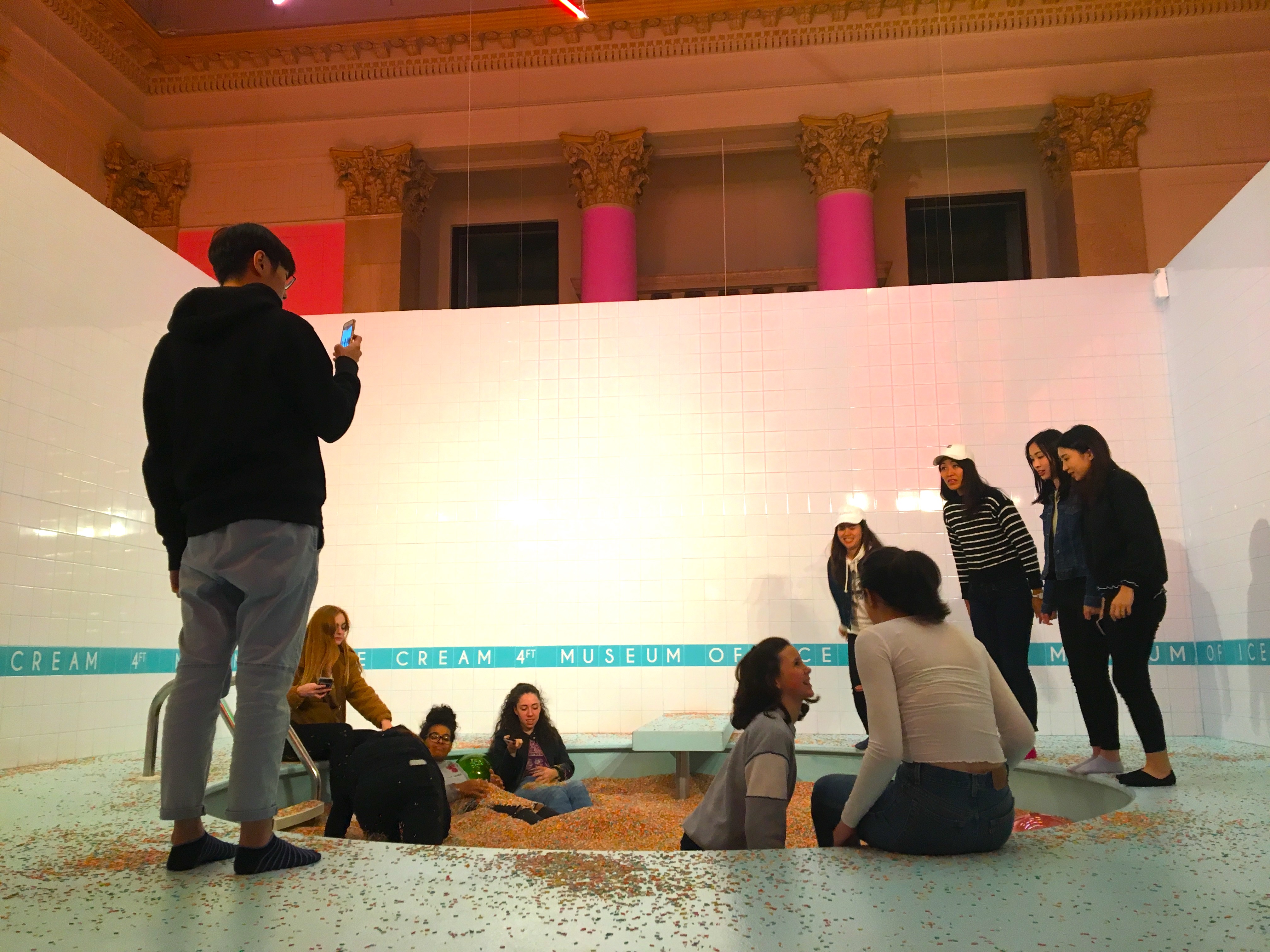Stepping into the Museum of Ice Cream (MOIC) is stepping into a whimsical candy land filled with cotton candy clouds, sprinkle pools, and unicorn statues. Millennials and teenagers swarm the rooms filled with life-size sweets and glossy rainbow walls. The bright decor invites social media fiends to capture and post photos of the museum. The museum’s photographability and design have spurred conversation about whether the works in the MOIC should even be considered “art.”
The Museum of Ice Cream has generated revenue of $20 million since 2016, when the museum first opened its doors in New York City. The $18 tickets sold out in the first five days, leaving 200,000 people on a waitlist. The “Instagrammability” of the museum was taken advantage of, as photos of the colorful, quirky exhibit quickly flooded Instagram feeds including those of celebrities such as Gwyneth Paltrow, Beyonce, and Katy Perry. The evident popularity and success allowed for the 25-year-old founder, Maryellis Bunn, to expand to three more locations: Miami, Los Angeles, and San Francisco.

The museum’s installation art is intriguing to social media enthusiasts. Installation art is an artistic genre in which an interior environment is transformed. Artists frequently redesign a space by installing three-dimensional sculptures or interactive, light fixtures and immersive sound and video elements.
Oleg Osipoff, visual arts teacher at Lick-Wilmerding, says that based on the works he has observed by David Ireland, an American installation artist, the intent of an installation artist is most likely “to provide a tidbit of their life to the audience.” Osipoff highlights the advantages of installation art by adding that “the audience gets to see the things that really matter to this artist, not through just a single picture or painting or sculpture, but instead through an entire three-dimensional experience.”
Similarly, artist and one-time MOIC visitor Raphaela Donohoe 19’ believes that the purpose of installation art “is to create an environment in which the viewer sees themselves.” Donohoe feels that this intimacy is one of installation art’s most crucial characteristics, as the viewer is intended to interpret and experience the art in the actual environment rather than through a screen. However, after visiting the Museum of Ice Cream, she said that the museum seemed to lack the “story” and intimacy that she believes is at the core of installation art, adding that the art seemed to lack depth and any potential for connection between the artist and visitor.
The first feature that visitors encounter at the MOIC is a row of three massive boxes enveloped in patterned wallpaper. Bright lights line the top edge of the display, casting a glow on the visitor inside. Teenage Instagram user and recent museum visitor Miley Sherman said that it almost seemed impossible that a viewer could interact with this installation in any way except by taking a photo. In fact, it seemed that if a MOIC-goer wasn’t taking photos or eating ice cream, there wasn’t much else to do.
Ten random visitors were interviewed and asked about their motivations for attending the MOIC. Nine reported that they discovered the MOIC through social media and most likely would not have visited if photography was prohibited, as it often is in more traditional art museums. Only one person said they found out about the museum through word of mouth. This happened to be the same person who said they “wouldn’t mind if photography wasn’t allowed… I came for the experience.” To them, phones create barriers between the spectator and the art.
The Museum of Ice Cream is marketed as an “art experience.” Each installation is accompanied by a museum label that details the name of the work, the date and description, confirming that the MOIC resembles an art museum. However, many Instagram users, who, having been overwhelmed with countless posts of people posing amidst the installations, have formed strong opinions on whether the installations should even be considered art. An anonymous LWHS junior believes that the Museum of Ice Cream’s simply “degrades what art is.” They feel that art is “not about getting a photo” and should have a “timeless quality,” characteristics that she believes the museum does not have.
Rosana Castrillo Diaz, the recipient of the SFMoMA’s 2004 Society of the Encouragement of Contemporary Art award, said that when working she doesn’t create with the intent to please an audience or be photographed, rather she “worries about the questions I need to answer and the goals I need to achieve.” The artwork is a reflection of the “conversations we are having with ourselves [artists] or with society.” Diaz adds that the younger generation of social media users are “used to having the information right way and not having to fight or took too much for it,” unlike the typical art museum experience which often involves patient personal interpretation rather than simply taking a photo.
The Museum of Ice Cream is not the only “Instagram pop-up museum” that has profited off of the social media craze. The Color Factory, Candytopia, The Happy Museum, and the Museum of Selfies, are all examples of other exhibits that cater to younger social media users. The success of these “instagrammable” exhibits has prompted traditional art museums, such as the San Francisco Museum of Modern Art (SFMOMA) to consider implementing more interactive, photographable and immersive art in order to attract a younger crowd. The popularity and publicity of “Instagram art museums”, such as the MOIC, has revealed the effects of social media on the ways in which art is displayed, created and consumed. As the influence of social media takes over the world, the rapidly increasing number of Instagrammable pop-up museums is proof that the art industry is racing to keep up.







